 "Who's a Bright
Spark
then!" "Who's a Bright
Spark
then!"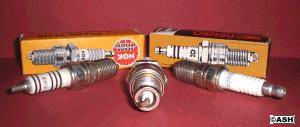 The Spark Plug
- a tiny little item in our motor bike engine, but oh so critical! Its primary purpose in
life is to ignite the
petrol and air mixture using high voltage electricity. But it has a
secondary purpose also and that is, - it must also be capable of
removing heat from this part of the engine. The Spark Plug
- a tiny little item in our motor bike engine, but oh so critical! Its primary purpose in
life is to ignite the
petrol and air mixture using high voltage electricity. But it has a
secondary purpose also and that is, - it must also be capable of
removing heat from this part of the engine.
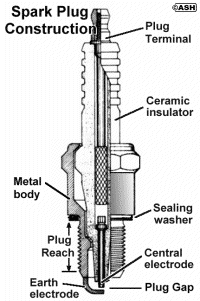 So are they all the
same then? So are they all the
same then?
Well basically
yes, the construction of the spark plugs are very similar and except
for material technology improving there has not been much in the way
of changes for over 60 years - yes I did say 60 years!
It is very important however
to make sure you fit the correct recommended plug type for each
engine, as an incorrect plug fitment can at very least harm
performance and cause breakdowns, and at worst destroy your
motor!!!
So lets first look at some
of the more obvious differences -
Spark Plugs come in different
lengths - classified as Long Reach and Short
Reach Plugs.
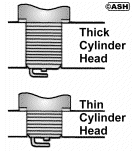 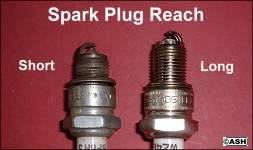
14mm threaded plugs have been the most common
fitment for over 40 years (thread diameter not spanner size), but
some modern engines and especially four stroke motorcycle engines use plugs
with very small thread diameters. 12mm is common on these and even
10mm on some specialist engines. In case your wondering why, -
smaller plug sizes leave more room in the cylinder head for bigger
valves and even 4and 5 valves, hence these engines can produce more
power!!!
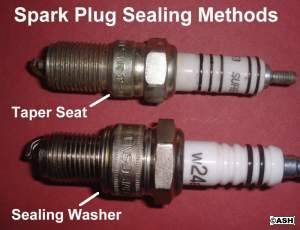
Spark plugs also come with
different sealing methods. As the plugs
themselves are a fairly hard metal, a sealing method is necessary to
prevent high pressure combustion gases escaping past the threads.
Many plugs use a soft crushable washer which can be obtained in a
range of thicknesses, the other common method is a tapered seat plug
(not common on motorcyccles yet), these do NOT need a sealing washer as they are designed to fit
into cylinder heads with a tapered recess! ONLY fit the correct
sealing type for your engine!
Besides the makers name, plugs come with
all sorts of fascinating on them! The example shown here is taken
from a typical NGK spark plug.
|
NGK - B P
R 8 E S |
|
1. |
2. |
3. |
4. |
5. |
6. |
7. |
1. The
makers name.
2. Thread Diameter - B = 14mm.
3. Projected Insulator.
4. Resistor type
plug.
5. NGK's
Heat Rating.
6. Plug reach - E = 19mm.
7. Super wide range
electrode.
Spark plugs are
designed to work at the correct temperature for each engine. 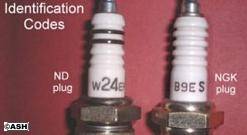 Too cold they will foul up easily, too hot
and the plug tip will glow red and pre-ignite the fuel
mixture, which can lead to engine destruction! For NGK a number 5 is a
fairly hot running plug, designed to go into a
lower performance engine. A NGK number 9 is a very cold running
plug which is
designed to go into a highly tuned engine, it will conduct heat away
from the electrode tip quickly so that it will not start to glow red
hot. Too cold they will foul up easily, too hot
and the plug tip will glow red and pre-ignite the fuel
mixture, which can lead to engine destruction! For NGK a number 5 is a
fairly hot running plug, designed to go into a
lower performance engine. A NGK number 9 is a very cold running
plug which is
designed to go into a highly tuned engine, it will conduct heat away
from the electrode tip quickly so that it will not start to glow red
hot.
These numbers
unfortunately are different for each spark plug manufacturer. An NGK
9 is r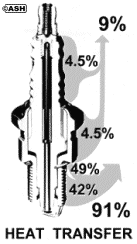 oughly equivalent to an ND 27. And Champion plug numbers run
from hot to cold the opposite way around altogether, so never make
an assumption or guess, - your engine could be at stake! oughly equivalent to an ND 27. And Champion plug numbers run
from hot to cold the opposite way around altogether, so never make
an assumption or guess, - your engine could be at stake!
From the drawing here you can see where spark plugs are
designed to lose their heat. It is essential that plugs are
tightened correctly as nearly half of the heat is conducted away
from the sealing washer area and if loose will cause the tip to
overheat.
In recent years
many Speedway racing
engines recently had troubles after they had their
aluminium cylinder head fitted with steel thread insert for the
spark plug, not realising that they would need to change their plug
heat grade due to much poorer heat conduction!

It is interesting
to note that although using different designs, most manufacturers
claim their spark plugs are better than everyone else's! In the
early 80's Bosch claimed a 2.5 horsepower advantage on a 'typical'
car engine, it may have been true. I will only say that it would not be
very difficult to set up a series of tests to suit almost any plug,
which would prove that each of them are the best at something!! So
you will have to draw your own conclusion on this.
Study these
graphs below to see what really affects spark plug and hence engine
performance.
Shown here are
some typical graphs which display characteristic performance
changes, relating to plug types, settings and other related
conditions.
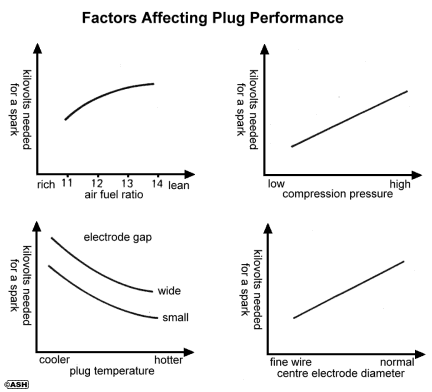
To prevent radio
and TV interference all modern motor vehicles are fitted with resistive
plugs (and leads). The law states that a total resistance of 10K
ohms must be in the High Voltage circuit for each spark plug. This
is often divided between the plug and the leads - at 5K ohms each
and is normally designated by an 'R' in the plug coding.. Be warned,
not using a resistive plug when one is specified can damage
sensitive electronic equipment like fuel injection and electronic
ignition units.
Reading spark
plugs, i.e. Studying their condition when removed, can
prove an invaluable tool in diagnosing an engine.
 |
Engine
detonation - causes peppered specks or cracks around the
insulator nose. |
 |
Pre-Ignition - can also show peppered specks or
melted electrode tips. |
 |
Fuel
mixture analysis - White = weak mixture, Black = rich
mixture, Rich tea biscuit colour = correct
mixture. |
 |
Oil
problems - If the engine is starting to burn oil, the plug
will be covered in white powder. If the plug is shiny black,
then it is oil fouling and will shortly
fail. |
Fine wire
electrodes do provide better starting and performance on very highly
tuned engines and will also resist associated fouling problems, but
are a lot more money. Fitting new plugs regularly is definitely a
benefit also, but always test them. I never race on an untested
spark plug, I have made that mistake before and so have many others.
Fitting a brand new set of duff plugs just before the a race start.
Fitting colder plugs than required will lose you a small amount of
horsepower and will foul up and need replacing far
sooner.
Finally always use
the manufacturers recommended torque settings, - this is critical
and will prevent over tightening which can lead to thread stripping
in the cylinder head, or even worse if loose on a racing engine,
serious internal engine damage through failing to dissipate
heat!
As a rough
guide - for 10mm, 12mm and 14mm spark plugs only if torque
settings are not available, NGK suggest to screw the spark plug in
finger tight until it is seated firmly home and then tighten 1/2 a
turn for plugs with a gasket and 1/16 of a turn for taper seat plugs
without a gasket.
So what should the
spark plug gap be? On a personal level I have always found that
on my 2 stroke competition dirt bikes, plugs work best at between
22-24 thou, 0.55-0.6mm.
Well
I hope you have enjoyed this, the first of a series of Technical Articles designed to help you get the most from
your Dirtbikes.
Now
get out there and have an enjoyable 'Dirty' month !!!
Until next time saludos - Adrian Harris 
(NB: This article is offered
as an item of interest only and Biker's Website, DirtyBiking and the author take
no responsibility for any misinterpretation by any reader resulting
harm or damage to either themselves or any
equipment.)
Article
Copyright © Adrian Harris 16/01/03. Not to be
reproduced without prior permission.
|